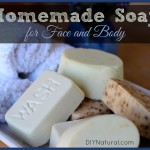
How to Make Soap for Hand & Body
Learn how to make soap from Debra Maslowski, an expert veteran homemade soap maker. Her natural process is simple, versatile, and successful!
Ingredients
- ⅔ cup unrefined coconut oil (to produce good lather)
- ⅔ cup olive oil (which makes a hard and mild bar)
- ⅔ cup almond oil (grapeseed, sunflower, or safflower oil will also work, just make sure it's a liquid oil)
- ¼ cup lye (100% sodium hydroxide. Also sold at local hardware stores.)
- ¾ cup cool water (distilled or purified)
Instructions
Step 1
-
Cover your work area with a newspaper. Put your rubber gloves, goggles, and other protective safety gear on. Measure your water into the quart canning jar. Have a spoon ready. Measure your lye, making sure you have exactly ¼ cup. (Some people insist on using a lye calculator. You don't need it for this recipe because I have perfected the amounts by weight.) Slowly pour the lye into the water, stirring as you go. Stand back while you stir to avoid the fumes. When the water starts to clear, you can allow it to sit while you move to the next step.
Step 2
-
In the pint jar, add your three oils together. They should just make a pint. Heat in a microwave for about a minute, or place the jar of oils in a pan of water to heat. Check the temperature of your oils – it should be about 120° or so. Your lye should have come down by then to about 120°. Wait for both to cool somewhere between 95° and 105°. This is critical for soapmaking. Too low and it’ll come together quickly, but be coarse and crumbly.
Step 3
-
When both the lye and oils are at the right temperature, pour the oils into a mixing bowl. Slowly add the lye, stirring until it’s all mixed. Stir by hand for a full 5 minutes. It’s very important to get as much of the lye in contact with as much of the soap as possible. After about 5 minutes, you can keep stirring or you can use an immersion blender (like this). The soap mixture will lighten in color and become thick. When it looks like vanilla pudding it’s at “trace” and you’re good to go. (Watch this video to see what trace looks like.)
Step 4
-
Add your herbs, essential oils, or other additions at this point. Stir thoroughly to combine. Pour soap mixture into the silicone mold and cover with plastic wrap. (Smooth out with a spatula if necessary.) Set in an old towel and wrap it up. This will keep the residual heat in and start the saponification process. Saponification is the process of the base ingredients becoming soap.
Step 5
-
After 24 hours, check your soap. If it’s still warm or soft, allow it to sit another 12-24 hours. When it’s cold and firm, turn it out onto a piece of parchment paper or baking rack. If using a loaf pan as your mold, cut into bars at this point. Allow soap to cure for 4 weeks or so. Be sure to turn it over once a week to expose all the sides to air (which is not necessary if using a baking rack). For a DIY soap drying rack, I took an old potato chip rack and slid cardboard fabric bolts (from a fabric store) through the rungs.
Step 6
-
When your soap is fully cured, wrap it in wax paper or keep it in an airtight container. Hand made soap creates its own glycerin, which is a humectant, pulling moisture from the air. It should be wrapped to keep it from attracting dust and debris along with the moisture.
Recipe Video
Notes
When you’re done making soap, always clean your equipment that has been exposed to lye. You can neutralize the lye with white vinegar, then wash the equipment well as you normally would. For the rest of it, let it sit for several days. Why? Because when you first make soap, it’s all fat and lye. You’ll be washing forever and you could burn your hands on the residual lye. If you wait, it becomes soap and all it takes to clean it is a soak in hot water.
For more information on cold-process soaps and hot-process soap making, check out our other soapmaking articles here.